1.
Sucher E, Sucher R, Gradistanac T, Brandacher G, Schneeberger S, Berg T. Autoimmune hepatitis-immunologically triggered liver pathogenesis-diagnostic and therapeutic strategies. J Immunol Res. 2019;2019:9437043.
2.
Sherigar JM, Yavgeniy A, Guss D, Ngo N, Mohanty S. Seronegative autoimmune hepatitis a clinically challenging difficult diagnosis. Case Rep Med. 2017;2017:3516234.
3.
Beland K, Marceau G, Labardy A, Bourbonnais S, Alvarez F. Depletion of B cells induces remission of autoimmune hepatitis in mice through reduced antigen presentation and help to T cells. Hepatol. 2015;62(5):1511-1523.
4.
Floreani A, Restrepo-Jimenez P, Secchi MF, et al. Etiopathogenesis of autoimmune hepatitis. J Autoimmun. 2018;95:133-143.
5.
Longhi MS, Ma Y, Bogdanos DP, Cheeseman P, Mieli-Vergani G, Vergani D. Impairment of CD4(+)CD25(+) regulatory T-cells in autoimmune liver disease. J Hepatol. 2004;41(1):31-37.
6.
Bhumi SA, Wu GY. Seronegative autoimmune hepatitis. J Clin Transl Hepatol. 2023;11(2):459-465.
7.
Yan C, Wu H, Fang X, He J, Zhu F. Platelet, a key regulator of innate and adaptive immunity. Front Med. 2023;10:1074878.
8.
Domerecka W, Kowalska-Kepczynska A, Homa-Mlak I, et al. The usefulness of extended inflammation parameters and systemic inflammatory response markers in the diagnostics of autoimmune hepatitis. Cells. 2022;11(16):2554.
9.
Liu L, Cao J, Zhong Z, et al. Noninvasive indicators predict advanced liver fibrosis in autoimmune hepatitis patients. J Clin Lab Anal. 2019;33(7):e22922.
10.
Ustaoglu M, Aktas G, Kucukdemirci O, Goren I, Bas B. Could a reduced hemoglobin, albumin, lymphocyte, and platelet (HALP) score predict autoimmune hepatitis and degree of liver fibrosis? Rev Assoc Med Bras. 2024;70(1):e20230905.
11.
Nawalerspanya S, Tantipisit J, Assawasuwannakit S, Kaewdech A, Chamroonkul N, Sripongpun P. Non-invasive serum biomarkers for the diagnosis of cirrhosis in patients with autoimmune hepatitis (AIH) and AIH-primary biliary cholangitis overlap syndrome (AIH-PBC): red cell distribution width to platelet ratio (RPR) yielded the most promising result. Diagnostics. 2024;14(3):265.
12.
Czaja AJ. Autoantibody-negative autoimmune hepatitis. Dig Dis Sci. 2012;57(3):610-624.
13.
Tasneem AA, Luck NH. Autoimmune hepatitis: clinical characteristics and predictors of biochemical response to treatment. J Transl Int Med. 2020;8(2):106-111.
14.
Alvarez F, Berg PA, Bianchi FB, et al. International autoimmune hepatitis group report: review of criteria for diagnosis of autoimmune hepatitis. J Hepatol. 1999;31(5):929-938.
15.
Hu B, Yang XR, Xu Y, et al. Systemic immune-inflammation index predicts prognosis of patients after curative resection for hepatocellular carcinoma. Clin Cancer Res. 2014;20(23):6212-6222.
16.
Taylor SA, Assis DN, Mack CL. The contribution of B cells in autoimmune liver diseases. Semin Liver Dis. 2019;39(4):422-431.
17.
Than NN, Jeffery HC, Oo YH. Autoimmune hepatitis: progress from global immunosuppression to personalised regulatory T cell therapy. Can J Gastroenterol Hepatol. 2016;2016:7181685.
18.
Wang H, Feng X, Yan W, Tian D. Regulatory T cells in autoimmune hepatitis: unveiling their roles in mouse models and patients. Front Immunol. 2020;11:575572.
19.
Wang QX, Jiang WJ, Miao Q, et al. Clinical and histological features of autoantibody-negative autoimmune hepatitis in Chinese patients: a single center experience. J Dig Dis. 2013;14(4):175-180.
20.
Tamimi TA, Sallam M, Rayyan D, et al. Clinical characteristics of autoimmune hepatitis in a middle eastern population: a tertiary care center experience. J Clin Med. 2023;12(2):629.
21.
Cargill T, Culver EL. The role of B cells and B cell therapies in immune-mediated liver diseases. Front Immunol. 2021;12:661196.
22.
Xia N, Hasselwander S, Reifenberg G, et al. B lymphocyte-deficiency in mice causes vascular dysfunction by inducing neutrophilia. Biomedicines. 2021;9(11):1686.
23.
Mercado LA, Gil-Lopez F, Chirila RM, Harnois DM. Autoimmune hepatitis: a diagnostic and therapeutic overview. Diagnostics. 2024;14(4):382.
24.
Azizi G, Ziaee V, Tavakol M, et al. Approach to the management of autoimmunity in primary immunodeficiency. Scand J Immunol. 2017;85(1):13-29.
25.
Miao Q, Bian Z, Tang R, et al. Emperipolesis mediated by CD8 T cells is a characteristic histopathologic feature of autoimmune hepatitis. Clin Rev Allergy Immunol. 2015;48(2):226-235.
26.
Cognasse F, Hamzeh-Cognasse H, Lafarge S, et al. Human platelets can activate peripheral blood B cells and increase production of immunoglobulins. Exp Hematol. 2007;35(9):1376-1387.
27.
Ramirez GA, Manfredi AA, Maugeri N. Misunderstandings between platelets and neutrophils build in chronic inflammation. Front Immunol. 2019;10:2491.
28.
Fu H, Zheng J, Cai J, et al. Systemic immune-inflammation index (SII) is useful to predict survival outcomes in patients after liver transplantation for hepatocellular carcinoma within hangzhou criteria. Cell Physiol Biochem. 2018;47(1):293-301.
29.
Song Y, Guo W, Li Z, Guo D, Li Z, Li Y. Systemic immune-inflammation index is associated with hepatic steatosis: evidence from NHANES 2015-2018. Front Immunol. 2022;13:1058779.

